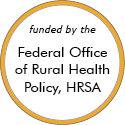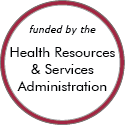Minnesota Models and Innovations
These stories feature model programs and successful rural projects that can serve as a source of ideas. Some of the projects or programs may no longer be active. Read about the criteria and evidence-base for programs included.
Promising Examples
The Rural Virtual Infusion Program

Updated/reviewed November 2025
- Need: Allow rural cancer patients in a region inclusive of 26 counties in Iowa, Minnesota, and South Dakota to have access to tertiary-level chemotherapy regimens administered in rural infusion centers.
- Intervention: With telehealth-based oversight from a tertiary care oncology team, 3 rural infusion teams were trained to coordinate cancer treatment plans and administer complex chemotherapy regimens.
- Results: The original grant-supported effort — with its results of saving130 patients 65,000 trip miles and 1,800 travel hours – proved sustainable.
Other Project Examples
Implementation of a Nursing Veterans' Initiative to Transform Education (INVITE)

Updated/reviewed September 2025
- Need: To support rural veterans pursuing a career in nursing.
- Intervention: The INVITE program improved the curriculum and reworked admission requirements to better support veteran students' experiences in the College of St. Scholastica undergraduate nursing program.
- Results: The number of veterans pursuing nursing has more than doubled since program implementation, and all students have reported an increased interest in serving rural communities.
FirstLink Care and Support Program
Updated/reviewed July 2025
- Need: To reduce suicide and substance-related deaths in North Dakota and Minnesota.
- Intervention: The Care and Support program provides support through phone calls, cards, and texting to those who have called suicide helplines or were referred by a healthcare provider.
- Results: In 2024, FirstLink sent 2,870 cards and texts to program participants and made 12,378 total contacts.
University of Minnesota Psychiatric-Mental Health Nurse Practitioner Rural Rotation
Updated/reviewed April 2025
- Need: To address shortages of nurse practitioners and mental health professionals in rural Minnesota.
- Intervention: The University of Minnesota (UMN) School of Nursing implemented a 40-hour rural rotation for students in the psychiatric-mental health nurse practitioner program.
- Results: 29 students completed rural rotations in communities across the state; several students voiced a new openness to practicing in a rural area after participating in the program.
Rural Aging Action Network
Updated/reviewed January 2025
- Need: To connect isolated older adults and family caregivers in rural Minnesota, Montana, North Dakota, and South Dakota to services and supports so they can age in place.
- Intervention: The Rural Aging Action Network is a national collaborative of organizations that mobilize whole communities to address gaps in care for older adults and family caregivers.
- Results: Since 2022, the collaborative has reached over 600 older adults and over 100 family caregivers living in rural communities.
Tri-Valley Opportunity Council Rural Transportation
Updated/reviewed November 2024
- Need: Public transportation options in a rural 8-county area in northwest Minnesota.
- Intervention: A coordinated public transportation and volunteer driver system which serves northwest Minnesota.
- Results: Increased ridership and affordable access to transportation for residents of 8 counties in rural, northwest Minnesota.
Montevideo Medical Academy
Added July 2024
- Need: To increase the future healthcare workforce in rural Minnesota.
- Intervention: Montevideo Medical Academy helps students explore healthcare career options and gain college credit.
- Results: So far, 25 students in the program have attained 170 college credits, 55 certifications, and 304 hours of clinical experience.
Targeted Rural Health Education Project
Updated/reviewed January 2024
- Need: Dual platform to teach both plain language use and health literacy principles to health professions students and disseminate health information to rural populations.
- Intervention: Writing project using community-specific public health data in order to write a plain language health education article suitable for publication in a rural newspaper.
- Results: Since program start in 2017, over 60 students have successfully published their plain language health education articles in 17 rural newspapers in 3 states.
The Minnesota Integrative Behavioral Health Program
Updated/reviewed May 2023
- Need: Out of 79 Critical Access Hospitals (CAHs) surveyed in Minnesota in 2015, behavioral health was the most frequently cited service requested.
- Intervention: In response, Rural Health Innovations launched the Minnesota Integrative Behavioral Health Program. This initiative engaged representatives across all sectors in health integration between hospital, primary care, and community services.
- Results: Strategy sessions resulted in the creation of resource directories to improve care coordination, evaluation measurements to document results, and an overall better understanding of integrative care challenges.
Isanti County SafeCab Program
Updated/reviewed August 2022
- Need: To reduce the number of deaths and injuries caused by drunk driving in Isanti County.
- Intervention: The SafeCab program provides alternative transportation home for bar patrons who would otherwise drive impaired.
- Results: The program is credited with a significant decrease in DUI (Driving Under the Influence) arrests and the lower average corresponding BAC (Blood Alcohol Content) levels in Isanti County.
Last Reviewed: 11/28/2025

